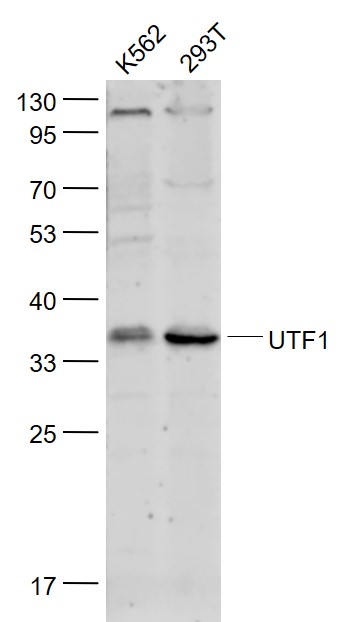
Rabbit Anti-UTF1 antibody
hUTF 1; hUTF1; Undifferentiated embryonic cell transcription factor 1; UTF 1; UTF1_HUMAN.
View History [Clear]
Details
Product Name UTF1 Chinese Name 未分化胚胎Stem cells转录因子1抗体 Alias hUTF 1; hUTF1; Undifferentiated embryonic cell transcription factor 1; UTF 1; UTF1_HUMAN. Research Area Developmental biology Signal transduction Stem cells transcriptional regulatory factor Epigenetics Immunogen Species Rabbit Clonality Polyclonal React Species Human, (predicted: Mouse, Rat, Cow, ) Applications WB=1:500-2000 ELISA=1:5000-10000 IHC-P=1:100-500 IHC-F=1:100-500 ICC=1:100-500 IF=1:100-500 (Paraffin sections need antigen repair)
not yet tested in other applications.
optimal dilutions/concentrations should be determined by the end user.Theoretical molecular weight 36kDa Cellular localization The nucleus Form Liquid Concentration 1mg/ml immunogen KLH conjugated synthetic peptide derived from Human UTF1: 101-170/341 Lsotype IgG Purification affinity purified by Protein A Buffer Solution 0.01M TBS(pH7.4) with 1% BSA, 0.03% Proclin300 and 50% Glycerol. Storage Shipped at 4℃. Store at -20 °C for one year. Avoid repeated freeze/thaw cycles. Attention This product as supplied is intended for research use only, not for use in human, therapeutic or diagnostic applications. PubMed PubMed Product Detail UTF1 is a 341 amino acid protein that localizes to the nucleus and is subject to post-translational phosphorylation. Associating with the TFIID complex via an interaction with the TATA box binding protein (TFIID), UTF1 binds to the N-terminal region of ATF-2 and, via this binding, acts as a transcriptional coactivator of ATF-2, thereby enhancing transcriptional activity. Human UTF1 shares 64% homology with its mouse counterpart, suggesting a similar role between species. The gene encoding UTF1 maps to human chromosome 10, which houses over 1,200 genes and comprises nearly 4.5% of the human genome. Defects in some of the genes that map to chromosome 10 are associated with Charcot-Marie Tooth disease, Jackson-Weiss syndrome, Usher syndrome, nonsyndromatic deafness, Wolman’s syndrome, Cowden syndrome, multiple endocrine neoplasia type 2 and porphyria.
Function:
Acts as a transcriptional coactivator of ATF2.
Subunit:
Binds to the N-terminal region of ATF2. Associates with the TFIID complex through interaction with TBP.
Subcellular Location:
Nucleus.
Post-translational modifications:
Phosphorylated.
SWISS:
Q5T230
Gene ID:
8433
Database links:
UniProtKB/Swiss-Prot: Q5T230.1
Product Picture
Bought notes(bought amounts latest0)
No one bought this product
User Comment(Total0User Comment Num)
- No comment



 +86 571 56623320
+86 571 56623320
 +86 18668110335
+86 18668110335

